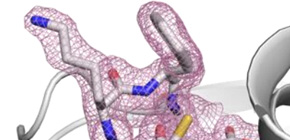
Discovery of low noise, low viscosity, and low cost carrier of proteins for serial crystallography (SFX)
A joint group of researchers led by SUGAHARA Michihiro and Group Director IWATA So (both are from the SACLA Science Research Group, Spring-8 Center, RIKEN), Assistant Professor MASUDA Tetsuya at the Graduate School of Agriculture, Kyoto University, Associate Professor SUZUKI Mamoru at the Research Center for State-of-the-Art Functional Protein Analysis, Institute for Protein Research, Osaka University, and Team Leader TONO Kensuke at the XFEL Project Head Office, Japan Synchrotron Radiation Research Institute (JASRI), discovered that it was possible to achieve a stable supply of crystals and reduction of background scattering noise at low cost by using hydroxyethyl cellulose as a protein crystal carrier for serial femtosecond crystallography (SFX), which was performed at the SPring-8 Angstrom Compact free electron Laser (SACLA) at the X-ray Free Electron Laser (XFEL) facility.
Unlike experiments conducted under conventional low temperature (100K, -173℃), SFX does not cause radiation damage and enables the determination of the crystal structures of proteins at temperatures close to physiological condition in vivo. However, crystals from a large amount of sample, 10~100 mg of proteins, were required.
In 2014, this joint group developed a grease matrix as a carrier, by which a small amount of protein crystals mixed with high viscosity grease was extruded through injector nozzles to perform X-ray analysis of protein crystals. This method has reduced the consumption of protein crystals necessary for structure analysis to 1/10~1/100 (reducing the amount of proteins to be used to 1mg or less), compared to a conventional liquid jet injection to jet liquid samples from injectors.
However, as background scattering noise from grease was produced in this method, this group introduced hyaluronic acid with lower background scattering noise in SFX. However, the stable flow for samples was difficult because hyaluronic acid had high viscosity and was more expensive than hydroxyethyl cellulose.
This time, this joint group solved the problems of noise, viscosity, and cost by using hydroxyethyl cellulose as a protein carrier medium for SFX. The use of hydroxyethyl cellulose holds promise for high-resolution crystal structure analysis of various proteins, including potential protein drug targets.
Figure 1
To learn more about this research, please view the full research report entitled “ Hydroxyethyl cellulose matrix applied to serial crystallography ” at this page of the Scientific Reports website.
Related link
- Suzuki Unit, Institute for Protein Research, Osaka University (link in Japanese)
